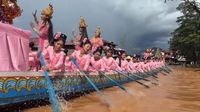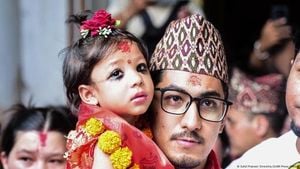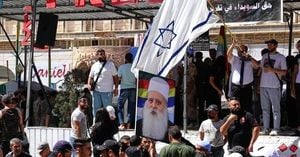The tranquil waters of Inle Lake shimmered this week with golden reflections and the rhythmic splash of oars, as Myanmar’s Phaung Daw Oo Pagoda Festival returned to life—though not without scars. Once a beacon for both devout Buddhists and international tourists, this two-week celebration in southern Shan state, about 420 kilometers northeast of Yangon, has weathered a relentless barrage of crises in recent years. Yet, as traditional barges glided across the lake on Tuesday, September 23, 2025, carrying their precious golden Buddha statues and flanked by celebrants in dazzling attire, the festival’s enduring spirit shone through the gloom of tragedy and upheaval.
According to the Associated Press, the Phaung Daw Oo Pagoda Festival is a major Buddhist event, revered for its elaborate rituals and its spectacular procession. At the heart of the festival is a gold-gilded barge, crowned with the image of the mythical Karaweik bird, which ferries four sacred Buddha statues to 21 villages around the lake. Each stop allows villagers to pay homage, a tradition cherished for generations. Fishermen from the Intha ethnic minority, famous for their unique leg-rowing technique, steer the smaller wooden boats that escort the barge, creating a scene as picturesque as it is steeped in history.
But the beauty of this year’s festival masks a deeper struggle. The shadow of a devastating 7.7 magnitude earthquake that struck Myanmar on March 28, 2025, still looms large. According to E Guard Environmental Services, more than 3,800 people were killed nationwide, with central Myanmar bearing the brunt. Inle Lake, though spared the worst, was far from untouched. Villages perched on stilts above the water saw up to 90 percent of their homes damaged or destroyed. Local estimates, though not officially confirmed, suggest that between 50 and 90 people lost their lives in the area, and more than 13,000 were affected.
"Not all the houses are standing straight, if you look carefully. To get them back to their original state, they will have to be repaired when the lake dries up in the summer," said Nyi Nyi Zaw, a 42-year-old ethnic Intha from Heyarywarma village, as reported by the Associated Press. His own house was among those damaged in the quake. The urgency of repairs, coupled with a scarcity of skilled craftsmen familiar with traditional construction techniques, has forced many to rebuild quickly and imperfectly. “The tourism industry in Inle collapsed after the pandemic, then came the political change in 2021, and there was the flood last year. It was like miseries overlapping one upon another,” Nyi Nyi Zaw reflected. Once a tour guide, he now works as a general laborer, emblematic of the region’s battered but resilient workforce.
The festival’s recent history reads like a litany of setbacks. The COVID-19 pandemic in 2020 forced the first major curtailment of celebrations. The following year, the military’s ouster of Aung San Suu Kyi’s elected government plunged the country into civil war, leading to another suspension. 2023 saw a brief resumption, but widespread flooding in 2024 prompted yet another cancellation. This year, the festival’s return was bittersweet—overshadowed by the fresh trauma of the earthquake and the ongoing instability that has gripped Myanmar since the 2021 coup.
Despite these hardships, the festival persists, a testament to the tenacity of local traditions and the people who keep them alive. Ma Win, a traditional textile seller from Inle Lake, described the community’s determination: “It’s been years since the Buddha statues came to our village. So we are participating as much as we can.” Even as business remains poor and the future uncertain, locals continue to honor their heritage, finding solace and strength in rituals passed down through generations.
On Tuesday, the lake was alive with color and spectacle. Traditional barges, golden statues, and celebrants in vibrant costumes brought a sense of joy and unity, if only for a moment, to a country still reeling from disaster and division. As reported by global news outlets, the festival is one of Myanmar’s biggest Buddhist celebrations, drawing crowds from across the region and, in better times, from around the world. But this year, the mood was tempered—joy mingled with remembrance, celebration shadowed by loss.
For many, the festival is more than a religious observance; it’s a lifeline to a sense of normalcy and community. The procession of the golden barge, the chanting of prayers, and the shared meals along the lake’s edge offer a brief respite from the relentless challenges of daily life in Myanmar. The sight of the Karaweik barge gliding from village to village, Buddha statues gleaming in the sun, is a powerful reminder of continuity in the face of change.
The festival’s resilience has not gone unnoticed. Observers note that, even as the tourism industry has faltered and infrastructure remains fragile, the people of Inle Lake have managed to preserve their unique cultural identity. The traditional houses—many rebuilt in the old style, though often lacking the craftsmanship of previous generations—stand as symbols of both loss and hope. As Nyi Nyi Zaw pointed out, true restoration will take time and resources, but the will to rebuild is undiminished.
Natural disasters are not new to the region, but the combination of the earthquake, political instability, and economic hardship has created a perfect storm of adversity. The festival’s continued existence speaks volumes about the priorities of the local community: faith, tradition, and the unbreakable bonds that tie families and neighbors together. Even as the world’s attention shifts from one crisis to the next, the people of Inle Lake quietly persist, rowing forward—sometimes with one leg wrapped around an oar, always with their hearts anchored in tradition.
As the golden barge completes its journey across Inle Lake, visiting each of the 21 villages, the festival’s message is clear. In the face of overwhelming odds, the people of Myanmar’s Shan state have chosen to celebrate life, honor their ancestors, and look forward with cautious hope. The festival may not be as grand as in years past, and the scars of recent disasters are still visible, but the spirit of Phaung Daw Oo endures—glinting on the water, echoing in the prayers, and living on in the hearts of those who call Inle Lake home.




